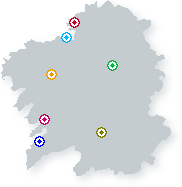| Census 1991 Knowledge of Galician in the most important cities of Galicia is important because partial socio-linguistic studies show that Galician is mostly used in rural areas where two thirds of the population live. The latest data show that the urban population, a large proportion of which has come from rural areas, has a high degree of knowledge and language skills in Galician. |
 | |||||||||||||||||||||||||||||||||||||||||||||||||||||||||||||||||||||||||||||||||||||||||||||||||
| ||||||||||||||||||||||||||||||||||||||||||||||||||||||||||||||||||||||||||||||||||||||||||||||||||
|
Advances in the social recovery of Galician, for years disparaged for the
reasons given above, have been made because of the use of the language in
public life. There has been a qualitative rise in the official usage of
Galician, especially with the inclusion of Galician in the media, the administration and teaching; this rise has led to a change in values and attitudes concerning the social esteem of the language. These changes are efficient in holding back the trend towards speaking Spanish which has stood firm in certain sectors and levels of society for centuries. According to data drawn from questions on the levels of usage, only 7.7% of the inhabitants of Galicia does not use Galician and this percentage includes immigrants. Galicia was not a destination for emigrants; it was quite the opposite, except for groups of Basques and Catalans in the business world, so there have never been large groups speaking different languages. The most highly developed provinces in Galicia, A Coruña and Pontevedra, -that is, those which have seen the greatest industrialisation, population increase and greatest modernisation, where people from different origins, of different classes and with new values, came together- are more accustomed to using Spanish as well as Galician. But even so, these provinces give figures of about 80% of the population speaking Galician regularly. | ||||||||||||||||||||||||||||||||||||||||||||||||||||||||||||||||||||||||||||||||||||||||||||||||||
Back to Galician today